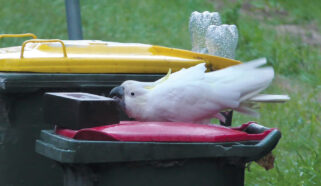
Human trash can be a cockatoo’s treasure. In Sydney, the birds have learned how to open garbage bins and toss trash around in the streets as they hunt for food scraps. People are now fighting back.
Bricks, pool noodles, spikes, shoes and sticks are just some of the tools Sydney residents use to keep sulphur-crested cockatoos (Cacatua galerita) from opening trash bins, researchers report September 12 in Current Biology. The goal is to stop the birds from lifting the lid while the container is upright but still allowing the lid to flop open when a trash bin is tilted to empty its contents.
This interspecies battle could be a case of what’s called an innovation arms race, says Barbara Klump, a behavioral ecologist at the Max Planck Institute of Animal Behavior in Radolfzell, Germany. When cockatoos learn how to flip trash can lids, people change their behavior, using things like bricks to weigh down lids, to protect their trash from being flung about (SN Explores: 10/26/21). “That’s usually a low-level protection and then the cockatoos figure out how to defeat that,” Klump says. That’s when people beef up their efforts, and the cycle continues.
Researchers are closely watching this escalation to see what the birds — and humans — do next. With the right method, the cockatoos might fly by and keep hunting for a different target. Or they might learn how to get around it.
In the study, Klump and colleagues inspected more than 3,000 bins across four Sydney suburbs where cockatoos invade trash to note whether and how people were protecting their garbage. Observations coupled with an online survey showed that people living on the same street are more likely to use similar deterrents, and those efforts escalate over time.
One option people used to try to deter the pesky parrots from getting into the trash was spikes on the top of the bin lid.Barbara Klump/Max Planck Institute of Animal Behavior
Tricks such as attempting to scare the parrots off with rubber snakes don’t work very well, Klump says. Nor does blocking access with heavy objects such as bricks; cockatoos use brute force to push them off. Hanging weights from the front of the lid or wedging items such as sneakers and sticks through a bin’s back handles work better. The team didn’t see any birds get inside bins with these higher levels of protection
The findings hint at an arms race, Klump says, but the missing piece is how the birds will respond as people try new ways of blocking bins. Some survey responses suggest that the parrots are learning.
“Bricks seemed to work for a while, but cockies got too clever,” one survey respondent wrote. “Neighbours on other side of highway suggested sticks. They work.”
Cockatoos have been raiding trash bins in the suburbs of Sydney. People have come up with creative ways to deter them, but those tools don’t always work as well as intended.
It would be interesting to explore the benefits and issues of different methods from the perspective of both humans and birds, says Anne Clark, a behavioral ecologist at Binghamton University in New York who wasn’t involved with the work. “I’m curious the degree of effort that people put into this and whether sometimes that effort limited their use of one solution versus another.” Some people, for instance, might not have the time to attach a small weight to the lid of the bin or might depend on their children, who can’t lift heavy bricks, to put out the trash.
In the same vein, cockatoos may stay away from tactics that take too long to beat. Bricks, for instance, are easy to quickly push off a bin; breaking sticks or pool noodles wedged through the bin’s back handle could take more time. Perhaps if enough people in a neighborhood adopt a highly effective method, Clark says, the cockatoos may not find it worth it to stop by.

 A new treatment could restore some mobility in people paralyzed by strokes
A new treatment could restore some mobility in people paralyzed by strokes  What has Perseverance found in two years on Mars?
What has Perseverance found in two years on Mars?  This robot automatically tucks its limbs to squeeze through spaces
This robot automatically tucks its limbs to squeeze through spaces  Greta Thunberg’s new book urges the world to take climate action now
Greta Thunberg’s new book urges the world to take climate action now  Glassy eyes may help young crustaceans hide from predators in plain sight
Glassy eyes may help young crustaceans hide from predators in plain sight  A chemical imbalance doesn’t explain depression. So what does?
A chemical imbalance doesn’t explain depression. So what does?